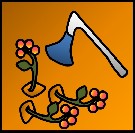Recognizing Weeds / Reconnaître des adventices
Weed infestation is one of the major constraints to rice productivity and profitability in rice production. A good knowledge of weeds is therefore important in order to determine the causes of the infestation and have a good understanding of possible control measures.
Weeds can be divided into three groups:
Grasses
Grasses (Graminae) may look like rice when they are young (in fact, rice is a grass). They have long, thin leaves, usually with parallel vein, and the round and hollow stems are composed of segments separated with nodes. The roots are fibrous, rather than having a principal root.
Common annual grass weeds are Echinochloa crus-pavonis, E. colona and Ischaemum rugosum.
Go here to learn how to control grasses.
Sedges
Sedges (Cyperaceae) may look like grasses. They tend to have long, thin leaves, smooth solid stems that are triangular, polygonal or rarely round in cross - section; and, in general, they do not have nodes.
Sedges are widespread in inland-valley rice fields. The most frequent annual sedges are Cyperus difformis, Cyperus iria and Kyllinga pumila.
Go here to learn how to control sedges.
Broad-leaved weeds
The leaves of broad-leaved weeds are usually wider than those of the grasses and sedges, and have branched veins. The first leaves of seedlings are a pair. Broad leaves often have one principal root that develops into a tap root.
Broad-leaved weeds frequently found in rice fields in inland valleys are Ludwigia abyssinica, Sphenoclea zeylanica, Ipomea aquatica and Heteranthera callifolia. In general, they are easier to control than grasses and sedges.
Go here to learn how to control the broad-leaved weeds.













